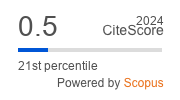Prolonged jaundice after previous SARS-CoV-2 infection: a clinical case report
https://doi.org/10.47093/2218-7332.2022.13.3.45-53
Abstract
The hepatobiliary system can be affected by a new coronavirus infection (COVID-19), in addition to the respiratory organs. Vanishing bile duct syndrome (VBDS) is a rare cause of jaundice that usually develops as a result of drug-induced liver injury or possibly due to the combined effect of several etiological factors.
Clinical case. A 77-year-old patient was hospitalized due to jaundice, skin itching and dark urine. Symptoms first appeared 1 month after COVID-19 treated with ceftriaxone and were accompanied by an increase in biochemical markers of cholestasis. Both extra- and intrahepatic bile ducts injuries were excluded. Liver histology revealed VBDS. Treatment with ursodeoxycholic acid for 11 months led to complete resolution of jaundice, regression of pruritus and a decrease in biochemical markers of cholestasis.
Discussion. This clinical case is of interest in connection with the development of VBDS in a patient after coronavirus pneumonia treated with ceftriaxone. VBDS is rarely included in the differential diagnosis of cholestatic syndrome, which is partly due to the lack of awareness of physicians about the complications that develop after COVID-19 and drug therapy.
About the Authors
N. G. VacheishviliRussian Federation
Nino G. Vacheishvili - clinical resident, Department of Internal Disease, Lomonosov Moscow State University.
1, Leninskie Gory, Moscow, 119991
Tel.: +7 (495) 932-88-14
M. S. Zharkova
Russian Federation
Maria S. Zharkova - Cand. of Sci. (Medicine), Head of Department of Hepatology, V. Vasilenko Clinic of Internal Diseases Propaedeutics, Gastroenterology and Hepatology, Sechenov First Moscow State Medical University (Sechenov University).
8/2, Trubetskaya str., Moscow, 119991
T. P. Nekrasova
Russian Federation
Tatyana P. Nekrasova - Cand. of Sci. (Medicine), Associate Professor, Institute of Clinical Morphology and Digital Pathology, Sechenov First Moscow State Medical University (Sechenov University).
8/2, Trubetskaya str., Moscow, 119991
I. N. Tikhonov
Russian Federation
Igor N. Tikhonov - Assistant Professor, Department of Internal Diseases Propaedeutics, Gastroenterology and Hepatology, Gastroenterologist, Department of Hepatology, V. Vasilenko Clinic of Internal Diseases Propaedeutics, Gastroenterology and Hepatology, Sechenov First Moscow State Medical University (Sechenov University).
8/2, Trubetskaya str., Moscow, 119991
N. I. Trofimovskaya
Russian Federation
Natalia I. Trofimovskaya - Gastroenterologist; Postgraduate Student, Department of Internal Diseases, Lomonosov Moscow State University.
1, Leninskie Gory, Moscow, 119991
V. T. Ivashkin
Russian Federation
Vladimir T. Ivashkin - Dr. of Sci. (Medicine), Professor, Academician of the RAS, Head of Department of Internal Diseases Propedeutics, Gastroenterology and Hepatology, Director of V. Vasilenko Clinic of Internal Diseases Propaedeutics, Gastroenterology and Hepatology, Sechenov First Moscow State Medical University (Sechenov University).
8/2, Trubetskaya str., Moscow, 119991
References
1. Fix O.K., Hameed B., Fontana R.J., et al. Clinical best practice advice for hepatology and liver transplant providers during the COVID-19 Pandemic: AASLD Expert Panel Consensus Statement. Hepatol 2020; 72(1): 287–304. http://doi:10.1002/hep.31281. PMID: 32298473
2. Li Y., Xiao S-Y. Hepatic involvement in COVID-19 patients: Pathology, pathogenesis, and clinical implications. J Med Virol. 2020; 92(9): 1491–1494. https://doi.org/10.1002/jmv.25973. PMID: 32369204
3. Zhao B., Ni C., Gao R., et al. Recapitulation of SARS-CoV-2 infection and cholangiocyte damage with human liver ductal organoids. Prot Cell. 2020; 11(10): 771-775. https://doi.org/10.1007/s13238-020-00718-6. PMID: 32303993
4. Faruqui S.M., Okoli F.C., Olsen S.K., et al. Cholangiopathy after severe COVID-19: Clinical features and prognostic implications. Am J Gastroenterol 2021; 116(7): 1414–1425. https://doi.org/10.14309/ajg.0000000000001264. PMID: 33993134
5. Sundaram V., Björnsson E.S. Drug-induced cholestasis. Hepatol Commun. 2017; 1: 726–735. http://doi.org/10.1002/hep4.1088. PMID: 29404489
6. Bakhit M., McCarty T.R., Park S., et al. Vanishing bile duct syndrome in Hodgkin’s lymphoma: A case report and literature review. World J Gastroenterol 2017; 14; 23(2): 366–372. https://doi.org/10.3748/wjg.v23.i2.366. PMID: 28127210
7. Anugwom C., Goetz G., Mohamed H. Vanishing bile duct syndrome preceding the diagnosis of Hodgkin Lymphoma. ACG Case Rep J 2020; 7(2): p e00336. https://doi.org/10.14309/crj.0000000000000336. PMID: 32440528
8. Bonkovsky H.L., Kleiner D.E., Gu J., et al. Clinical presentations and outcomes of bile duct loss caused by drugs and herbal and dietary supplements. Hepatol 2017; 65: 1267. https://doi.org/10.1002/hep.28967. PMID: 27981596
9. Conrad M.A., Cui J., Lin H.C. Sertraline-associated cholestasis and ductopenia consistent with vanishing bile duct syndrome. J Pediatr 2016; 169: 313. https://doi.org/10.1016/j.jpeds.2015.10.065. PMID: 26597434
10. Brennan P.N., Cartlidge P., Manship T., et al. Guideline review: EASL clinical practice guidelines: drug-induced liver injury (DILI). Front Gastroenterol. 2022; 13: 332–336. https://doi.org/10.1136/flgastro-2021-101886. PMID: 35722609
11. Guarino M., Perna B., Pastorelli A., et al. A case of ceftriaxone-induced liver injury and literature review. Inf Med. 2022; 30(2): 293–297. https://doi.org/10.53854/liim-3002-16. PMID: 35693049
12. Robles-Díaz M., Nezic L., Vujic-Aleksic V., Björnsson E.S. Role of ursodeoxycholic acid in treating and preventing idiosyncratic drug-induced liver injury. A systematic review. Front Pharmacol. 2021; 12: 744488. https://doi.org/10.3389/fphar.2021.744488. PMID: 34776963
13. Simental-Mendía M., Sánchez-García A., Simental-Mendía L.E. Effect of ursodeoxycholic acid on liver markers: A systematic review and meta-analysis of randomized placebo-controlled clinical trials. Br J Clin Pharmacol. 2020 Aug; 86(8): 1476–1488. https://doi.org/10.1111/bcp.14311. PMID: 32285958
14. Tikhonov I.N., Ivashkin V.T., Zharkova M.S., et al. Results of the non-interventional observational program: Influence of Novel COroNavirus on the condition of patients with liver and gastrointestinal Tract diseases and the effect of Ursodeoxycholic acid drugs and Rebamipide on the course of COVID-19 infection (CONTUR). Meditsinskiy sovet = Medical Council. 2021; (21-1): 106–119 (In Russian). https://doi.org/10.21518/2079-701X-2021-21-1-106-119. EDN: IYMVUM
15. Thuy P.X., Duy Bao T.D., Moon E.Y. Ursodeoxycholic acid ameliorates cell migration retarded by the SARS-CoV-2 spike protein in BEAS-2B human bronchial epithelial cells. Biomed Pharmacother. 2022; 150: 113021. https://doi.org/10.1016/j.biopha.2022.113021. PMID: 35658221
16. Izzo P., Gallo G., Codacci Pisanelli M., et al. Vanishing bile duct syndrome in an adult patient: Case report and review of the literature. J. Clin. Med. 2022, 11, 3253. https://doi.org/10.3390/jcm11123253. PMID: 35743323
17. André S., Picard M., Cezar R., et al. T cell apoptosis characterizes severe COVID-19 disease. Cell Death Differ 2022; 29: 1486–1499. https://doi.org/10.1038/s41418-022-00936-x. PMID: 35066575
Supplementary files

|
1. CARE Checklist | |
| Subject | ||
| Type | Исследовательские инструменты | |
Download
(20KB)
|
Indexing metadata ▾ | |







































